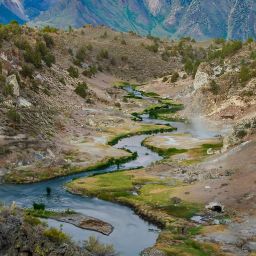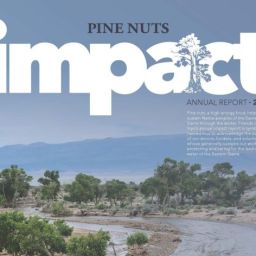
Long Valley Mining
Mammoth Lakes and Long Valley are characterized by striking geological features, which are one of the many things that make these areas special. One of these features was a hydrothermal system that carried gold from deep in the earth to the surface. European settlers conducted mining operations in the area during the 1800’s, and removed the easily accessible gold from the area.
In the early 1980’s there was a renewed interest in using modern technologies to retrieve small, or even microscopic, amounts of gold. Several companies revisited the Long Valley Caldera, and drilled for rock samples. Fortunately, the price of gold remained too low for the diffuse gold in these cores to result in development of a mining operation. Unfortunately, changes in the price of gold have emboldened mining companies to look for new locations to dig for profit. The introduction of new cyanide leaching technology, larger equipment, and the high risk business model of “junior mining companies” allowed for a new group of investors who hope to strike it rich in Long Valley.
KORE Mining hopes to ride high gold prices, technology, and finance opportunities to bring an open pit heap leach gold mine to southern Mono County. KORE’s proposed exploration site is within 10 miles of Mammoth Lakes (the county’s largest resort destination) and directly at the headwaters of a popular fishing (Hot Creek) and camping area. KORE does not care that its proposed activities threaten habitat for struggling species, and will damage an area that holds significance for local tribes, and supports Mono County’s recreational tourism economy. They also disregard a county ordinance making the chemical leaching process they hope to utilize illegal in Mono County. KORE Mining seeks profits above all else. Friends of the Inyo is part of a coalition of conservation organizations, local business and recreational interests that seek to protect Long Valley from Kore’s proposed operations.
Long Valley is a world class recreational destination drawing people from all over the world to recreate in Mammoth Lakes and the forested mountains of picturesque rural Mono County. It is also an important habitat for the Bi State Sage Grouse, a struggling species, and many other species that rely on the meadow environment. Further, the area is significant for local tribes who have occupied and used the area for thousands of years. Developing an open pit mine would degrade habitat for the grouse and other species, and destroy the area’s picturesque rural character. Further, Kore’s operations would jeopardize the water quality that the entire valley and City of Los Angeles rely upon.
Damage to Ecosystems
The area of Long Valley where Kore hopes to develop a mine is within proposed critical habitat for the imperiled Bi-state Sage Grouse and several breeding areas and leks are adjacent to the project site. The risk of disturbance is so high that the proposed drilling is planned to be halted several months out of the year. Developing this drilling into an industrial mining operation would produce many more hazards to these species including gigantic mining trucks, noise, and large scale surface disturbance of the already sparse habitat for these protected animals.
There are over 30 federal and state special status species within the project site, all would be negatively affected by this project. These include over 20 plant species, five fish species, four birds, two amphibians, two insects, and the Pygmy Rabbit. Any groundwater extraction, contamination, or surface water diversion in this area could affect Hot Creek and thereby impact the survival and recovery of Federally endangered Sierra Nevada yellow-legged frog and Owens tui chub which would adversely modify designated critical habitat. The coalition argues that these impacts tie the hands of the Forest Service who cannot approve projects that jeopardize the survival and recovery of these species.
Damage to Local Economy
Both the Town of Mammoth Lakes and Mono County have submitted letters of opposition to the Forest Service regarding Kore’s proposed project Beyond the impacts to local residents, Mammoth Lakes is a world class resort destination that contributes over 600 million dollars annually in direct spending. When including indirect impacts of tourism this number grows to over 840 million to the economy of the area each year. Visitor spending supported 5300 local jobs and provided over $2 million in tax revenue. A 2018 survey showed that half of these visitors came to the area for its scenic beauty and activities.1 Kore’s attempts to promote gold mining in Long Valley would destroy the scenic values and could jeopardize main activities in the summer like fishing or enjoying the hot springs, camping, and recreation options adjacent to the proposed mining site.
Damage to Water Quality and Availability
The company’s technical report states that the mining operation would consume large amounts of water—up to 600 gallons per minute for the life of the mine — and every drop of the water in the Long Valley is already allocated to either habitat or direct export to Los Angeles. In the permitting process, threatened and endangered species must take priority over any new user who hopes to drain the already overtaxed surface and groundwater of the valley. Kore does not offer an explanation for an alternative water source.
Heap Leaching Is Illegal in Mono County
After use in a mining operation, wastewater must be treated and retained or released into the drinking water supply of Los Angeles and the fragile headwater ecosystems around Hot Creek. For this reason, cyanide solutions and other heap leach processes are illegal in multiple states and counties across the United States after environmentally devastating spills in Montana and around the world poisoned aquifers and surface waters. Mono County passed an ordinance in 1998 banning the use of cyanide and other chemicals in the County to protect the water that the people, plants, and animals rely on from contamination, but Kore mining flaunts this ordinance in their technical report by having their consultant value their potential gold resource values assuming heap leaching methods.
Our coalition submitted detailed comments to the Inyo National Forest opposing the use of a Categorical Exclusion (CE), which is the lowest level of environmental review and very uncommon for mining explorations on Forest Service lands. CEs are generally granted when a project is expected to have no substantial environmental impact which is completely inappropriate for this drilling project. The use of CEs are extremely controversial and are unacceptable for projects with unmitigable impacts. Friends of the Inyo worked with the Town of Mammoth Lakes and Mono County to generate local government comments and create a groundswell of local opposition. During public scoping over 1,300 unique comments were received on the project.
Nevertheless, in September 2021, the Inyo National Forest gave Canadian Company KORE Mining the green light to begin exploratory drilling at Hot Creek. This permit was granted under the Categorical Exclusion process, which, again, provides for the lowest possible environmental review. Several organizations, including the Sierra Club Range of Light Group, Friends of the Inyo, Western Watersheds Project, and the Center for Biological Diversity sued KORE Mining and the US Forest Service on the grounds that the USFS had improperly granted the permits, ignoring the significant potential environmental impacts to Long Valley. These impacts would not just be to the land, but to wildlife, including dwindling Bi-State Sage Grouse populations as well as the endangered Owens Tui Chub fish. Further, the permit improperly failed to provide that all drilling and remediation work be completed within one year, which is required for projects operating under a Categorical Exclusion.
After the court ruled in favor of KORE and the USFS. The plaintiff groups appealed the ruling, and a hearing was scheduled to take place in late August 2023. However, it could be several months before the court renders a decision on the appeal.
KORE’s permit allows them to start drilling on September 1, 2023. The drilling will be conducted night and day bringing light, noise, and dust pollution to Long Valley for a year. Read a recent media release from KORE Mining detailing, in their own words, their planned mining operations.
Take Action
Let Inyo National Forest Leadership Know You Oppose KORE Mining’s Drilling at Hot Creek.
Updates
In case you missed it last Friday, August 18, please take a listen to Friends of the Inyo’s Executive Director, Wendy Schneider, and Campaign Organizer – No Hot Creek Mine, Emily Markstein, discuss our campaign to oppose Canadian company KORE Mining’s exploratory drilling for gold at Hot Creek with KMMT FM’s Arts, Culture & Entertainment Show Host John DeMaria. Happy listening…and if you like what you hear, happy sharing!
KORE Mining is getting ready to start spoiling the landscape at Hot Creek. Drilling operations could begin as early as September 1! Vulnerable species, tourism and Native American cultural values are at stake. Take Action Now!
Pine nuts, a high-energy food, helped sustain Native peoples of the Eastern Sierra through the winter. Friends of the Inyo’s annual impact report, which we usually release at mid-year to celebrate the previous year’s accomplishments, is symbolically named thus to acknowledge the support of our donors, funders, and volunteers, whose generosity sustains our work of protecting and caring for the land and water of the Eastern Sierra.
If you don’t read Friends of the Inyo’s Juniper E-Newsletter, you’ll never know all that we have coming up this month! And you might miss out on our Latino Conservation Week Outreach Event, Nature Connectivity and Credit, in Downtown Bishop Saturday afternoon/evening, July 15. There will be Latin music, raffles and FREE FOOD: Two tacos to the first 200 attendees, courtesy of AltaOne Federal Credit Union. Tell your amigos who don’t have credit – the primary aim of this event is to try to help people who are unbanked establish credit so they can access our National Parks, which are…
Friends: May is that in-between month when we apply Earth Day lessons learned in April, as we prepare for summer, which begins in June. Read about what Friends of the Inyo has been up to – with your support, of course – in the May Juniper! Happy reading! And if you like what you read, happy sharing!






